It was her father’s profession that made Shahla Chamanara spin like a faded dandelion in the wind. Her father’s job in particular determined her place of birth and her childhood playmates. A father from Sanandaj who always traveled from town to town with his wife because of his military career. This was the reason why Shahla was born on 8/3/1336 in Mahabad, far from the family’s hometown, Sanandaj. She spent her childhood in Mashhad, puberty in Qazvin and finally the dandelion with its bloody roots was executed and buried in this very city by the regime’s mercenaries. Shahla’s childhood was lost in her father’s endless missions. These journeys opened her child’s eyes to the suffering of people and pity and quarrel exchanged places with half-finished children’s games.
In this way a girl’s hair band was taken off in the storm and her dolls were wiped out. Every trip was an experience to see the suffering of other ethnic groups, and Shahla Chamanara saw that Kurds, Turkmens, Arabs and Azerbaijanis share a common pain. And that is the oppression that the Islamic regime inflicted on their hearts………….. The love for the motherland and the longing for visits from relatives had drawn Dandelion three times to Sanandaj. When she heard the story of Behrouz Ardalan, her mother’s cousin, and the story of his companions’ bravery, which was covered in blood during the 24-day war in Sanandaj, her anger and hatred turned into a volcano ready to erupt. Shahla had made her decision. She was determined to pursue the ideals of the bloody insurrection………….
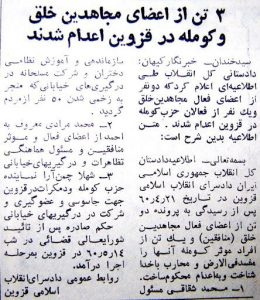
At the height of her beauty and femininity, Shahla was 24 years old and the calendar read 30/3/1360 (June 20, 1981). Around noon, Shahla visited her friend and stayed there for a few hours. Riots have been reported to sweep Tehran. The regime’s guards suppressed, killed and arrested people. Tehran was not far from Qazvin. As a result, word of the events in the capital quickly got around in this city. Fearful, Shahla made her way home, but the fear was less noticeable with her quick steps. She had now reached the city center and realized that the situation indicated sporadic protests in the area. She decided to quicken her pace when she saw a groaning woman in one of the alleys. She approached the woman to help her. The young woman could not hold her cover because of severe pain. She told about the attack by the Revolutionary Guards on the protesters and cried and showed the bruising of the Revolutionary Guards’ batons on her body. Shahla helped the woman to the side of the road in hopes of stopping one of the frightened cars. Shahla was wearing a Kurdish dress that day and no one knows if she joined the protesters or was caught by chance returning home. Desperate and helpless, Shahla took the wounded woman to the hospital, whose uniform was sufficient to show her collaboration with the Mojahedin Khalq organization. Shahla’s Kurdish clothing turned out to be her arrest warrant as described in the following lines. She herself stayed in the hospital to donate blood. That was enough for the two Basiji sisters of the hospital staff, Fatemeh and Fereshteh Dehbashi, who lived in the Shahla neighborhood, to surround her. With the cry of “She is a Komala”. The word “Komala” caused the Revolutionary Guards to attack Shahla in the hospital and to transfer her to “Choobinder” prison.
Fear of premature death drove Shahla and her cellmates to desperation to break the silence when they heard of mass executions, such as those in Nazi concentration camps, where the crime of the individual was limited to the victim’s race and political creed……………
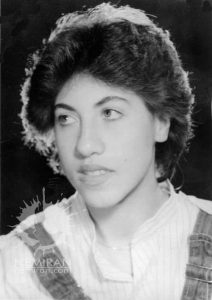
She was subjected to intermittent interrogation and psychological torture for a few days, attributed only to her Kurdish origins for working with opposition organizations and parties in Kurdistan. During this torture, the interrogator Davood Shakib, with a whip in hand, along with some guards, insulted the party leaders in Kurdistan, causing excitement and incitement to hatred and hostility on the part of Shahla. Despite her concealment about any organizational cooperation with parties, her pure and emotional defense was sufficient to link her name to one of the Kurdish leaders and to close the case. The head of the prison, Colonel Behzadpour, allowed the families of Shahla Chamanara to visit Mohammad Shaghayeghi and Hamid Moradi in pprison at the same time. The meetings took place in a corridor that was not yet dominated by a killing system, which resulted in a meeting between Shahla and Hamid Moradi. Hamid was a tall young man with a radiant face and a tangled blond forehead who was aware of his fate and death sentence. In this secret and brief encounter, he asked Shahla’s family to bring him a razor blade for the next meeting. He wanted to be fired with a handsome appearance and face in front of the execution squad on the wall.
When her family visited Shahla, they learned that she was tortured a lot. She even lost her sense of hearing in one ear. Shala’s courage and valor, and even her scolding of Khomeini, angered the prison guards and torturers. Her relatives remembered the darkness of those days: “” Shahla said that the interrogator cursed Sheikh Ezzadin Husseini and other Kurdish leaders instead of asking and interrogating, and sharing this with me was enough for us to disallow to visit her.”
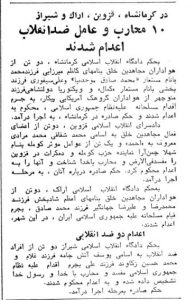
Shahla was transferred to an ordinary women’s prison until the verdict came from the court. The prison was a place where prostitutes were willing to sleep with prison guards in exchange for meager donations and visits from relatives. Shahlas brief presence among these women was so impressive that after some time the women did not submit to the regime’s mercenaries with any promises or rewards. This angered the guards and intensified the wave of torture on her body and soul.
In the last few days of interrogation Shahla was brought before the Revolutionary Court, located across from her parents’ house. Shahla asked her guard [1] to stop there to say goodbye to the days of the past with a sad look on the window of the house. The guard suddenly bit into her hand with all his might and hatred. He left a festering wound on her innocent body until the last day.
It is worth noting that Shahla Chamanara was no longer the rebellious and emotional girl of the past. She was so hardened by time and political work that the interrogators found the torture useless to break their silence. They prematurely agreed to her death sentence. Friends and relatives who did not know Shahla viewed her humility and warmth as inexperience and purely feminine outbursts. They imagined that these qualities led her to prison under the spell of encouragement and the storm of revolution………..
Shahla’s investigators accused her of armed cooperation with the Kurdish organization Komala (a left-wing organization). She was arrested for allegedly bringing weapons to Qom and offering them to the Komala troops in this city for military training. Shahla had never been to Qom before. Shahla was returned to solitary confinement after a month and a half. This happened at the time when Ayat [2] was murdered in Tehran. This event increased the despair and fury of the mercenaries in the torture chambers.
Shahla was executed on 6/5/1360 (6/8/1981) after a month and a half of imprisonment and severe torture, along with two men, Mohammad Shaghayeghi and Hamid Moradi. This was the reward of the mercenaries’ desperation for her silence under the lashes. The last supper happened behind the bars. Shahla’s mother could touch her weak hands in the last hours of her life. The interrogators had asked Shahla to go with them to Sanandaj until the last moment, to cooperate with them in order to track down her comrades.
“I was asked to go to Sanandaj to cooperate in tracking down comrades. I am offered all the comforts for this.” said Shahla to her visitors at the last meeting.
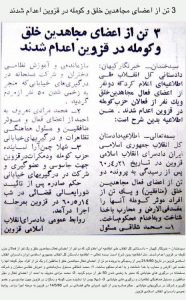
The father’s answer indicated the purity of an ideal that was also going on in Shahla today. “My daughter, we never want this freedom, we don’t let ourselves be fed like that.”
Shahla’s last question to the family was:” Has the sister returned to work after the suspension? “After the negative answer, she said:” She should never go back there. “
The last meeting showed that despite this pressure, Shahla was still concerned for her people and looking back at this meeting showed her pure and clear mind……………………………..
The day after the last visit, Shahla’s mother and older sister went to the Revolutionary Court. The interrogator quietly announced, turning the pages of the prisoners’ names, “Shahla has been executed, go and take the body.”
On 15/5/1360 (6/8/1981) the family received the body of the young Shahla. The corpse testified to the most brutal torture. Shahla was buried in Qazvin around 2:00 p.m. The body was washed and wrapped by Shahla’s step-grandmother and the grandmother of Siavash Dadashpours. The delicate body was still marked by cigarette butts and the pressure of handcuffs on the hands and two bullets, one in the heart and one in the head.
Shahla’s father, who was always happy, could no longer cope with this grief and died shortly after this tragedy.
The news of Shahla’s tragic death was shamelessly confirmed on the front pages of the morning papers as a document of the crimes of the regime with a bloody seal: “A member of Komala, sympathizer of the Democratic Party and sidekick of Palizban, was executed.”
The dandelion faded and landed on the floor. The Islamist fanatics went to their parents’ doorstep every Friday after Friday prayers and chanted the death slogan for the anti-revolutionaries. In all these years, her tombstone has not been spared their violence (the grave has been desecrated several times). Time and again, the tombstone became a thorn in the eye of the regime, proof that neither they forgive nor we forget. May your memory last forever.
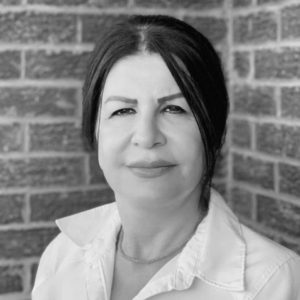
Author – Minoo Hamily
Thank you for the cooperation of the groups “Sanandaj Immortals” and “Lalakan”
[1]. Shahla’s bodyguard in the committee’s car was a well-known person named Mohammad Yatim who secretly worked with the committee’s agents. His undercover job was an ice cream seller. .
[2]. Hassan Ayat (born 3/4/1317, Najafabad – died on 14/5/1360 (5/8/1981), Tehran). He played an important role in drafting the Iranian constitution and incorporating the Velayat-e-Faqih principle. Yervand Abrahamian blames the Mojahedin Khalq organization for his murder.

